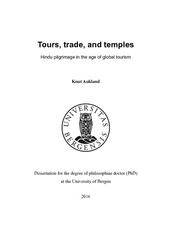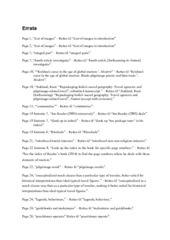| dc.description.abstract | Based on ethnographic research across various locations in Northern India between 2012–5, this dissertation investigates how Hindu pilgrimage has adapted to the rise of global tourism through four case studies. On a theoretical level it addresses the question of how to understand the relationship between pilgrimage and tourism. Earlier studies have tended to either contrast or conflate pilgrimage and tourism, often based on a typological approach that categorizes travellers as either tourists, pilgrims or somewhere in between. In the thesis introduction I provide an alternative by developing a theoretical approach that diverges from the dominant coordinates in earlier discussions. My theoretical approach comprises two main steps. First, I conceptualize pilgrimage and tourism as two identifiable domains of socio-cultural activities that historically have been sustained by different institutions and organizations, but that engage in an ongoing interplay. The interplay model allows us to analyze the ways in which actors, agencies and practices tied to each of these domains intersect and tie into one another. The dissertation shows how this interplay produces new combinations and configurations that are related to the removal of earlier religious patterns, but also generate new arrangements facilitating religiosity. Second, I focus on the hitherto largely overlooked role of mediators, intermediary agencies and formations that operate between pilgrims and the places they visit, including tourist guides, pilgrimage priests, guided tours, guidebooks, tourism departments, travel agencies, circuits, itineraries and package tours. The four articles of the dissertation thus target the modus operandi of Hindu pilgrimage in the age of global tourism, and the mediating structures that pilgrims and other travellers become entangled in and draw on when they travel to places of pilgrimage. In this way, the dissertation provides a fresh angle to the study of pilgrimage and tourism, shedding new light on contemporary Hinduism and Hindu pilgrimage and provides a cross-cultural framework for understanding the impact of modern tourism on pilgrimage traditions around the globe. The first article [published in Tourist Studies] investigates guided tours in Haridwar (Kankhal) and Rishikesh. Analyzing audio-recordings of the guide narratives, I find that the tours are structured according to a religio-commercial agenda that coordinates commercial and religious interests. The guides invoke a vast array of concepts and images from the reservoir of Hindu narratives and practices to promote the use and purchase of religious objects sold in shops that collaborate with the guides and give them a share of the profit. The article suggests that tourist guides and their guided tours have become integral parts of Hindu pilgrimage and its operation in the age of global tourism. In the second article [published in Modern Asian Studies] I explore the adaptive strategies adopted by pilgrimage priests (pandas) in Vrindavan in relation to changes ushered by tourism. Changing travel patterns have forced pandas to modify their services by adopting the role of the guide and by offering guided tours. They also collaborate with travel agencies or open their own travel agencies that combine priestly and tourist services. In order to secure an income, pandas modify familiar mythological narratives and use various rhetorical devices trying to stimulate pilgrims to give donations (dan) out of which the pandas get a share. While the forces of global tourism have helped diminish the traditional exchange system between panda and pilgrim, I argue that the commercial concerns as such do not represent a new development but resonate with the history of Hindu pilgrimage and the pandas' trade. In the third article [forthcoming in Journal of Contemporary Religion], I turn to the Himalayan Char Dham pilgrimage route. I argue that the growth of Char Dham was predicated on the involvement of the public tourist boards and tourist bureaucrats who saw in Char Dham a readymade (religious) concept to be turned into a tourism circuit. A content analysis of Char Dham guidebooks is used to challenge the hypothesis that tourism development will result in a rebranding of pilgrimages that downplay religious dimensions and affairs. The inclusion of tourist activities and sites in the promotion of Char Dham is not replacing religious communication, but rather complementing it, or changing it by suggesting a correspondence between natural beauty and religious significance. Char Dham guidebooks still report miracles and provide instructions in ritual matters, while framing is as a picturesque pilgrimage, indicating a clear departure from pre-modern conceptions of nature. The fourth article [forthcoming in Numen] investigates the role of travel agencies in promoting pilgrimage tours in Delhi, Vrindavan and Haridwar. Surveying travel brochures I find that the market privileges circuits and destinations where pilgrimage and additional tourist resources cluster together, suggesting a dynamic relationship between India's sacred geography and a broader tourist geography. Non-religious tourist attractions and services do not compete with pilgrimage sites, instead the combined resources of pilgrimage and other tourism sites work to mutual benefit in popular itineraries. For most participants, these day tours are incorporated into larger journeys that are framed both with and without reference to religious purposes and pilgrimage. By collating these discoveries with findings from earlier studies I develop an analysis of overarching developments and implications in what I call pilgrimagerelated travel. Crucially, visits to pilgrimage sites are increasingly framed as darshan tours reflecting how increased scheduling, with swift temple visits, privileges darshan and donations as the principle religious act. Looking at the four articles collectively, I summarize my core findings in three propositions that are unfolded in the introduction: Proposition A: Movement and money condition the mediation of religion at places of pilgrimage. Proposition B: Tourism has not been a secularizing force, but rather brought changes in and a repositioning of the religious aspects of Hindu pilgrimage. Proposition C: The tourist industry and tourist boards are important co-creators of the current Hindu pilgrimage culture and the contemporary expression of India's sacred geography. | en_US |

